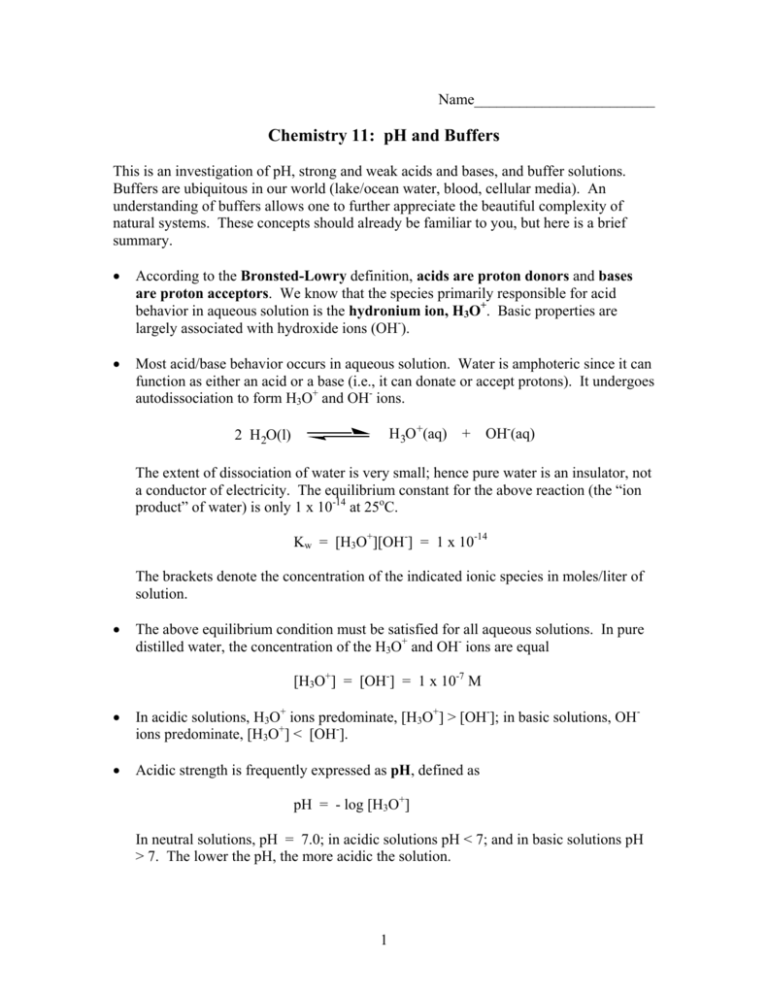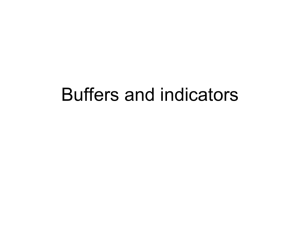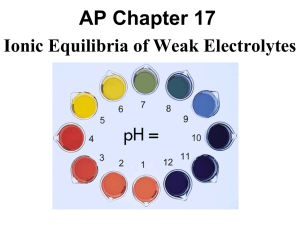pH and Buffers Lab: Chemistry Experiment
advertisement

Name________________________ Chemistry 11: pH and Buffers This is an investigation of pH, strong and weak acids and bases, and buffer solutions. Buffers are ubiquitous in our world (lake/ocean water, blood, cellular media). An understanding of buffers allows one to further appreciate the beautiful complexity of natural systems. These concepts should already be familiar to you, but here is a brief summary. • According to the Bronsted-Lowry definition, acids are proton donors and bases are proton acceptors. We know that the species primarily responsible for acid behavior in aqueous solution is the hydronium ion, H3O+. Basic properties are largely associated with hydroxide ions (OH-). • Most acid/base behavior occurs in aqueous solution. Water is amphoteric since it can function as either an acid or a base (i.e., it can donate or accept protons). It undergoes autodissociation to form H3O+ and OH- ions. H3O+(aq) 2 H2O(l) + OH-(aq) The extent of dissociation of water is very small; hence pure water is an insulator, not a conductor of electricity. The equilibrium constant for the above reaction (the “ion product” of water) is only 1 x 10-14 at 25oC. Kw = [H3O+][OH-] = 1 x 10-14 The brackets denote the concentration of the indicated ionic species in moles/liter of solution. • The above equilibrium condition must be satisfied for all aqueous solutions. In pure distilled water, the concentration of the H3O+ and OH- ions are equal [H3O+] = [OH-] = 1 x 10-7 M • In acidic solutions, H3O+ ions predominate, [H3O+] > [OH-]; in basic solutions, OHions predominate, [H3O+] < [OH-]. • Acidic strength is frequently expressed as pH, defined as pH = - log [H3O+] In neutral solutions, pH = 7.0; in acidic solutions pH < 7; and in basic solutions pH > 7. The lower the pH, the more acidic the solution. 1 • Strong acids, such as HCl, and strong bases such as NaOH are completely dissociated into their constituent ions in aqueous solution. • Weak acids are only partially dissociated or ionized. This means that an equilibrium is established between the dissociated and undissociated forms: HB(aq) + H2 O(l) H3O+(aq) + B-(aq) Ka = [H3O+][B-]/[HB] (1) Here HB is the weak acid and B- is its conjugate weak base. Note that pKa is defined in a way comparable to pH, i.e. pKa = - log Ka • Weak bases react with water to achieve equilibrium in which there is an excess of OH- ions. B-(aq) • + HB(aq) H2O(l) + OH-(aq) Kb = [HB][OH-]/[B-] (2) A buffer is a solution of a weak acid and its conjugate weak base. The equilibrium conditions given by equations (1) and (2) both hold in these solutions, though it is generally more convenient to use the version represented by (1) in calculations. Buffers are formulated so that change in pH on the addition of H3O+ or OH- is minimized. This is because the weak base, B-, will react with added H3O+ and the weak acid, HB, will react with added OH-. The equilibrium conditions represented by Ka continue to be satisfied. The Henderson-Hasselbalch equation is a convenient form of the Ka expression that is typically used for buffer calculations. pH = pKa + log([B-]/[HB]) In the first part of this experiment you will measure the pH of aqueous solutions of common chemicals; in the second part you will make some buffer solutions and study their properties. Experimental Procedures Part I: pH Use a pH meter to measure the pH values of 0.10 M solutions of the following compounds. Also put a drop or two of universal indicator in each solution. Record the pH and the color of each solution. Sodium chloride, NaCl pH: Color: Sodium hydrogen sulfate, NaHSO4 pH: Color: Sodium acetate, CH3COONa pH: Color: Acetic acid, CH3COOH pH: Color: 2 Sodium carbonate, Na2CO3 pH: Color: Sodium hydrogen carbonate, NaHCO3 pH: Color: For each solution with a pH less than 6 or greater than 8, write a net ionic equation that accounts for the observed pH. Part II: Buffers The laboratory contains 0.10 M solutions that can be used to make the following three buffer solutions. CH3COOH & CH3COO- acetic acid & acetate NH4+ & NH3 ammonium & ammonia HCO3- & CO32- hydrogen carbonate & carbonate Pick one of these pairs and identify the weak acid and its conjugate weak base. All of your subsequent experimental work will be done with this pair of chemicals. As you follow the procedures below, provide the requested calculations/observations/equations in the corresponding boxes. Label your data appropriately. Continue your work on additional sheets if the space in a box isn’t sufficient. 3 1. Mix 25 mL of your acid solution (let’s call it HB) with 25 mL of your base solution (B-), and measure the pH of the resulting buffer. From this information, you should be able to compute a numerical value for Ka of HB. Note that in this solution, [HB] = [B-]. 2. Divide your solution from (1) into two equal volumes. Add 10 drops of 0.10 M NaOH to one half and 10 drops of 0.10 M HCl to the other half. Measure and record the pH values of the solutions after the addition of NaOH and HCl. Write net ionic equations for the reactions that account for your observations. 3. Place 25 mL of distilled water into a beaker, measure its pH, add 10 drops of 0.10 M NaOH, and measure the pH again. Then place 25 mL of distilled water in another beaker, measure its pH, add 10 drops of 0.10 M HCl, and measure the pH again. Record these pH values and compare them with the results obtained in step 2. Explain the difference. 4 4. Make another buffer by mixing 5.0 mL of the solution containing your acid component and 50.0 mL of your base. Measure the pH of this solution. Account for any differences you observe between this value and the pH of the buffer in Step 1. Use your Step 4 results to calculate Ka and pKa for HB. 5. Make another buffer solution by mixing 50.0 mL of the solution containing your acid component and 5.0 mL of your base. Measure the pH of this solution. Account for any differences you observe between this value and the pH of the buffer in Step 1. Use your Step 5 results to again calculate Ka and pKa for HB. 6. Show your results to your laboratory instructor who will assign you a pH. Calculate the ratio of B- and HB you will need, and use your stock solutions to prepare a buffer having this pH. Measure and record the pH actually obtained. 7. In steps 1-6 you have mixed 0.10 M solutions of a weak acid and its conjugate base. For this part of the experiment you are asked to prepare a buffer from your weak acid 5 and a strong base, 0.10 M NaOH, or from your weak base and a strong acid, 0.10 M HCl. Calculate the volumes of the two solutions required to yield a buffer with the same pH you attempted to make in step 6. Prepare the buffer, measure, and report its pH. Safety and Waste Disposal The acids and bases used in this experiment are all dilute, but you should take the usual precautions. All solutions may be poured down the drain. Your report consists of these completed laboratory pages 6 Name____________________________ Chemistry 11 pH and Buffers - Advance Study Assignment Due on December 9, 2002 at noon 1. The pH of a 0.10 M solution of NaH2PO4 is 4.5. Write a net ionic equation that accounts for this observation. 2. HCN is a weak acid. The pH of a 0.10 M HCN solution is 5.2. a. Calculate the molarity of H3O+ in this solution. b. Calculate the molarity of CN- and HCN in this same solution. c. Use the above results to calculate a numerical value for Ka for HCN. Compare your value with that given in your text. 7 Name____________________________ pH and Buffers ASA (cont.) 3. A student is asked to use 0.10 M formic acid, HCOOH, and 0.10 M sodium formate, HCOONa to prepare a buffer solution having a pH of 3.40. Ka for HCOOH is 1.8 x 10-4. a. Identify the weak acid and its conjugate weak base in this buffer system. b. Calculate the volumes of the two solutions that need to be mixed to make 1.00 liter of this buffer. c. When 5 drops of 0.10 M HCl were added to 20 mL of this buffer, the pH went from 3.40 to 3.37. Write a net ionic equation that explains why the pH change was much smaller than it would have been if this volume of HCl were added to 20 mL of distilled water. 8








